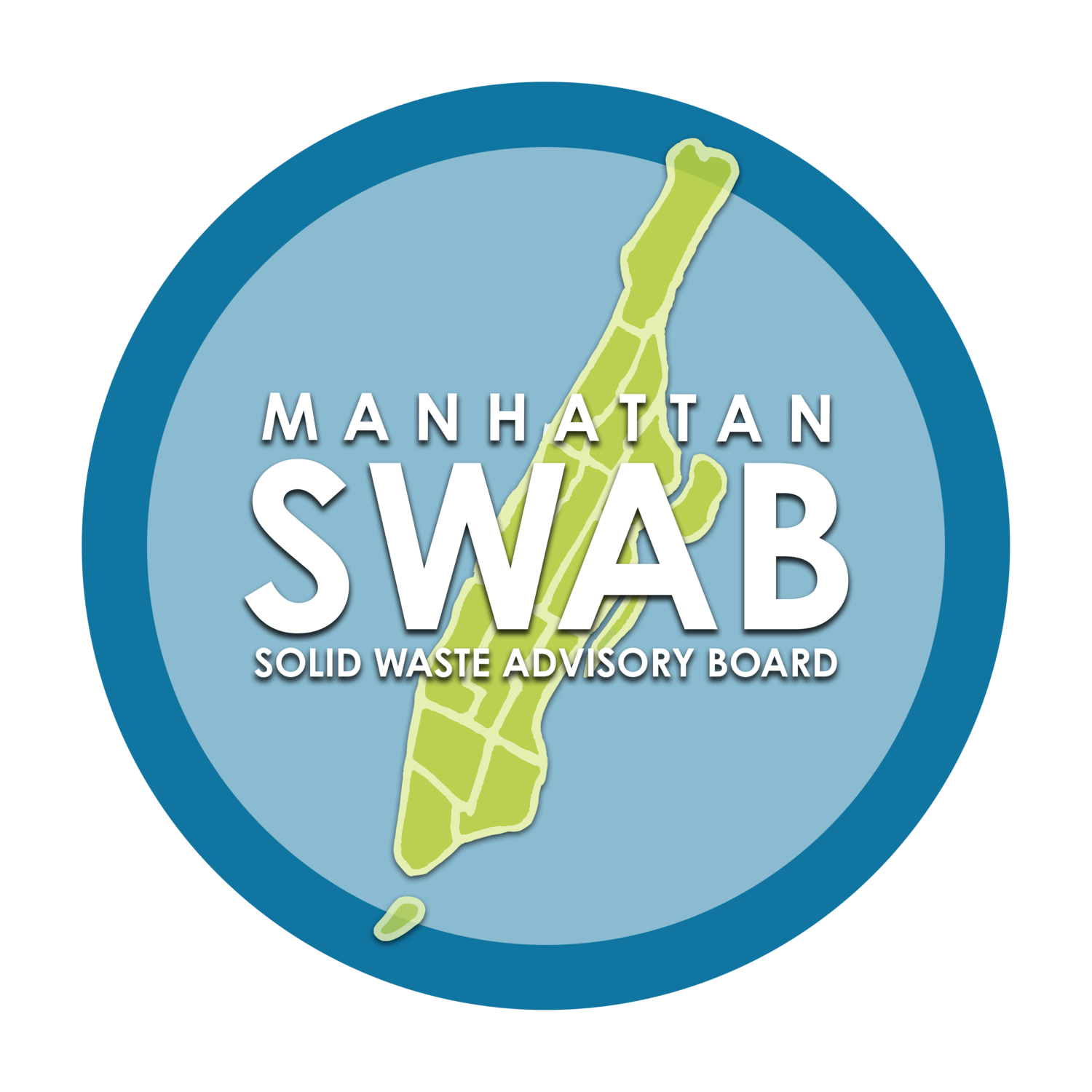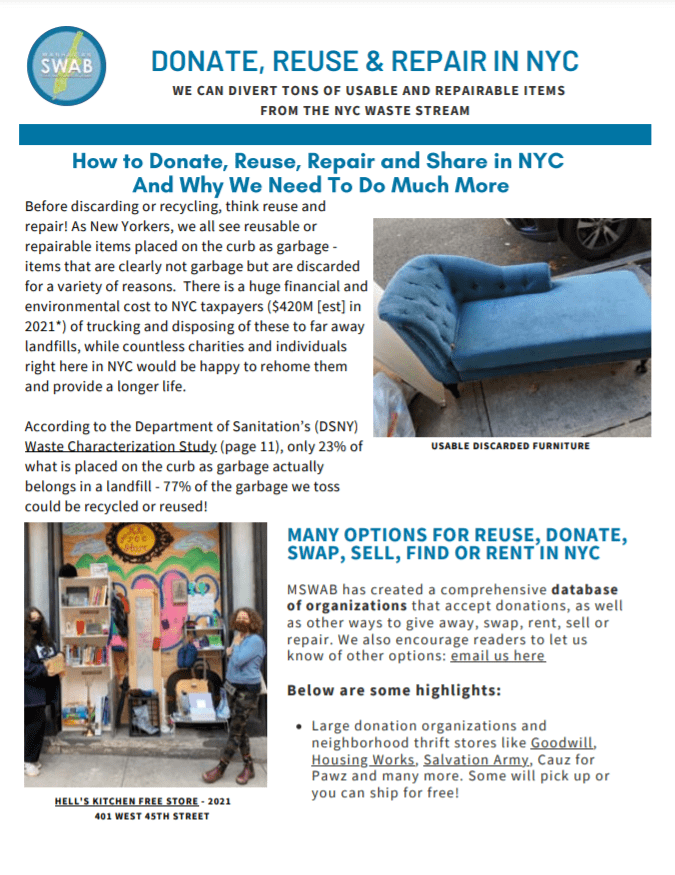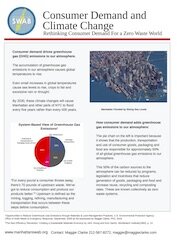These factsheets provide easy-to-read summaries of issues (and solutions!) across the waste stream.
Reopening Greener at NYC Cultural Institutions
cultural institutions
Visitor Operations
Back-of-House Operations
Cafeteria / Catering
Special Events
Staying Virtual
This guide helps cultural institutions devise and attain sustainable waste management goals in the time of COVID-19.
NYCHA Recycling Fast Facts
NYCHA
See how the MSWAB is supporting NYCHA’s Inner City Green Team to improve recycling access and engagement in public housing complexes.
Provide support to NYCHA via resource sharing, data reporting methods and program and metric development ideas for increasing recycling data collection;
Showcase and support community-led initiatives, such as Inner City Green Team, that prioritize ongoing zero waste education for NYCHA residents
ORGANICS RECYCLING & NYC HEALTH
Organics
DSNY:
collects 3.8 million tons of residential & governmental agency waste
spends $1.7 billion on collection & disposal
generates ~1 million tons of greenhouse gas emissions/year with landfilled trash (primarily due to organic portion)
sends waste 25 million miles per year, burning 11 million gallons of diesel fuel
discards 31% or 1 million tons of residential compostable organic material
Diverting organic matter from landfills is the simplest action to reach Zero Waste. This explains how.
YOU Can Reduce Pharmaceutical Drug Waste in New York City
pharmaceuticals
Medicines get into the environment
Keep medicine out of the wrong hands
How can I dispose of old medications I don't need?
Find a free collection site
What can I do with empty pill bottles?
Do not flush medications, do not put them down the drain
This one-page PDF provides instruction for reducing pharmaceutical waste in New York City
ADVANCING WASTE REDUCTION IN MULTI-FAMILY BUILDINGS
Residential Recycling
Find building Recycling Champion(s) to help build the case for management.
Set up Infrastructure such as bins and signage.
Encourage staff to enroll in DSNY's Zero Waste Building Maintenance Program.
Engage residents with posters, events, goodies, meetings, BuildingLink, tutorials.
Address issues, celebrate success, control participation via fines.
Quantify progress. Add E-Cycle or refashionNYC, sharing, or swaps.
Learn how staff and residents of multi-family buildings in NYC can improve recycling and reduce organics waste.
donate, reuse & repair in NYC
Residential Recycling
In an effort to reduce the large volume of reusable household items and furnishings thrown in the garbage and sent off to landfills, the MSWAB has compiled a list of organizations that will help you donate, share, sell, or swap the things you no longer want.
In addition to traditional thrift stores, there are now many other online alternatives for discarding unwanted items. In many ways, these are much easier options - perfect for those that don’t have the time or ability to drop off at a thrift store
Although this started as a resource for New York City, we welcome additions from the NYC Metro Area.
what is zero waste?
This factsheet explains Zero Waste and provides recommendations to help NYC get there.
Zero Waste means:
The conservation of all resources by means of responsible production, consumption, reuse, and recovery of products, materials, packaging, and food
That no materials go to landfill or incinerator
That no materials are discharged to land, water, or air, threatening environmental or human health
new york city has not made a long term commitment to zero waste
WASTE EXPORT
The City can still achieve its 0x30 plan if it takes the following actions:
The City must not sign "Put or Pay export/ disposal contracts that penalize the City for maximizing Zero Waste
City Council should legislate rigorous guidelines for the long term export contracts, including flexibility to maximize zero waste and a new form of export disposal contract that is more flexible -- with the ability to withhold (without penalty) reusable, recyclable and organic materials
City Council should review existing contracts and provide commentary before DSNY renews or renegotiates them
The City should create long-term contracts for organics processing and find local markets for biogas and agricultural uses
City or state should measure organics going to landfills, pass bans on organics to landfills, annually measure methane emissions from landfills used by NYC/NYS
Learn how New York City is paying an ever-increasing amount to export the city’s waste.
MEASURING COVID-19 IN WASTEWATER AN EARLY WARNING SYSTEM
People who have Covid-19 shed virus in their feces, and this shows up in wastewater. Because wastewater testing for bacteria and viruses is not new, when it became clear that the Covid-19 pandemic was a serious public health threat, researchers in the Netherlands started testing sewage in wastewater treatment plants in several cities winter of 2020. The researchers found that wastewater data predicted cases by a few days.
Wastewater Testing for SARS CoV2
Public Health Benefit
Individual Buildings Can be Tested
Using and Sharing Covid-19 Wastewater Data
Consumer Demand And climate change
Zero waste and climate change
Any Green New Deal or climate change mitigation legislation must include funding for Zero Waste programs that reduce the totality of carbon impacts from consumer demand for products, food and the associated packaging, because half of carbon emissions can be reduced by Zero Waste solutions.
Consumer demand drives greenhouse gas (GHG) emissions to our atmosphere.
How consumer demand adds greenhouse gas emissions to our atmosphere:
Municipal solid waste generation has tripled in the US since 1960.
The best path to Zero Waste requires reducing consumer demand combined with increasing reuse, repair, recycling, and composting
Learn how getting to Zero Waste is one of the most effective steps we can take to reduce carbon emissions.
Refrigerants, Climate Change, and Municipal Solid Waste
Refrigerants and the Harm They Cause
Refrigerants are components in refrigerators, freezers, air conditioners (including in cars), heat pumps, dehumidifiers, vending machines, water coolers, and many other appliances and machines. All of these are part of the City’s public and/or commercial solid waste streams.
Refrigerants in a Zero Waste Framework






















